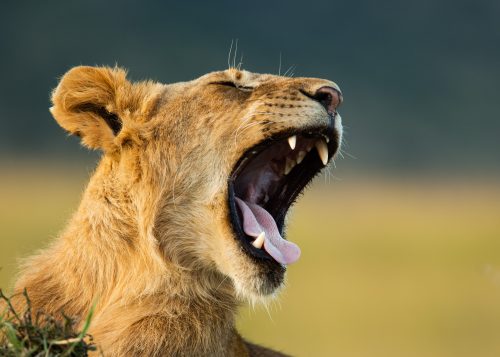After the short rains, the magnificent grasslands of the Mara are attractive to all kinds of bird species. This week, I spotted a breeding male pin-tailed whydah; these territorial males often have several females in their small group. They have an elaborate courtship flight display, which includes hovering over the female to show off its tail. A red-headed weaver was also seen building a nest near the Mara River — these are the only weavers with a slender red-orange bill.
Just below Angama Mara, the two remaining cubs of the Angama lioness were seen having a great time, playing and bonding with each other. These cubs hopefully hold a bright future in the rebirth of the Angama Pride. We would love to see them get to adulthood.
We recently caught up with Oloti, the nomad cheetah from Tanzania. We found him near the border, where the grass is shorter compared to the other parts of the Triangle. Cheetahs tend to love areas with short grass so they can scan for prey but also for their safety to be able to scan for other predators that may pose a threat to them. -Joseph Njenga
We spent a morning with Tawi, one of the many elephant bulls currently savouring the lush pasture in Kimana Sanctuary. The sun was rising, promising a scorching day ahead and Tawi was busy dust bathing. Elephants normally indulge in dust baths to cloak their sensitive skin with a protective layer against the sun's UV rays. As Tawi went about this skincare routine, a few more bulls joined him in what appeared to be a morning ritual.
Jackals, usually opportunistic hunters and scavengers, are often seen trailing big cats, hoping to capitalise on their kills. This week, we observed a trio of jackals stalking a herd of Grant’s gazelle. Their intent was likely to scope out the young ones in the herd, but luck was not on their side that day. The jackals soon exhibited some playful behaviour, revealing that they were merely seizing the moment, not driven by hunger.
Raptors have always tickled my fancy among the avian species and Kimana Sanctuary provides a unique opportunity to witness these captivating birds daily. A tawny eagle perched high on a tree caught my attention while it was quietly observing the world and planning its next move. Despite being skilled hunters, tawny eagles can't resist grabbing a quick bite from other birds of prey. Just days ago, Angama guide Salaash witnessed a tense encounter when a tawny eagle attempted to snatch a catch from a secretary bird. However, the secretary bird proved to be a formidable opponent and the tawny eagle lost its chance.
Speaking of secretary birds, these majestic birds of prey are captivating to observe, especially with a breeding pair currently in the Sanctuary. The breeding cycle, spanning five to six months from nest-building to fledgling, involves roosting and nesting in select trees with flat canopies, sometimes even on the ground. Incubation takes about 42 to 45 days, with pairs alternating duties. The sitting parent endures the elements, facing heat, rain and cold. This week, we were fortunate to catch a rare glimpse of a secretary bird brooding from above. We eagerly anticipate the moment when these incredible creatures finally hatch. -Sammy Njoroge
Filed under: This Week at Angama
Subscribe for Weekly Stories
Comments (1):
24 December 2023
I have enjoyed your photographs tremendously and the comments under each photo are really lovely. To all of you at Angama I wish you well over your Festive season.

Angama Safari Offers